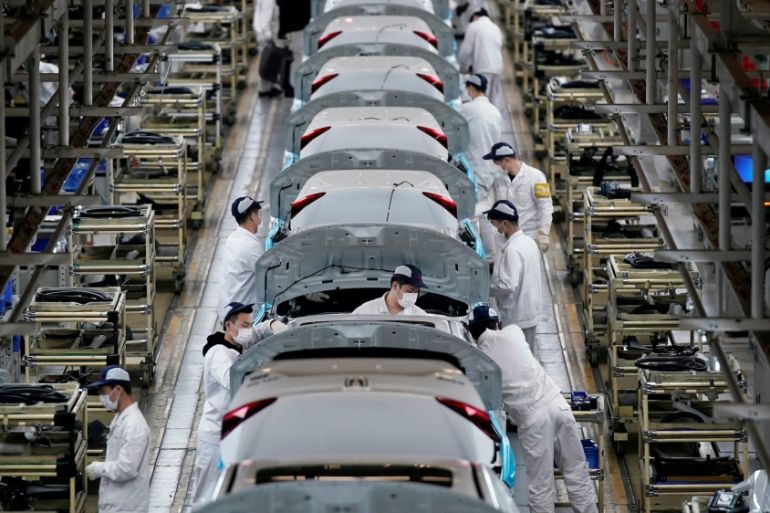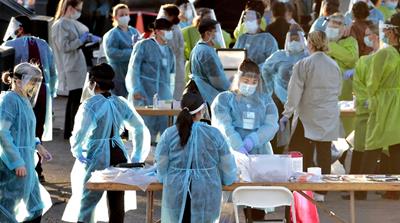Asian factories got a boost in June as virus restrictions eased
But surge in coronavirus cases in US and elsewhere dents hopes of a swift export-led recovery in Asia, surveys show.

Asia’s factory pain showed signs of easing in June, as a rebound in China’s activity offered some hope the region may have passed the worst of the devastation caused by the coronavirus pandemic.
But sluggish global demand and fears of a second wave of infections will tame any optimism on the outlook and keep pressure on policymakers to support their ailing economies.
Keep reading
list of 4 itemsMexico’s teachers seek relief from pandemic-era spike in school robberies
‘A bad chapter’: Tracing the origins of Ecuador’s rise in gang violence
Why is the US economy so resilient?
China’s factory activity grew at a faster clip in June after the government lifted coronavirus lockdown measures, a private-sector survey showed on Wednesday.
The region’s Purchasing Managers’ Index (PMI) surveys showed that manufacturing activity also expanded in Vietnam and Malaysia, pointing to a slow but steady recovery ahead.
But analysts warned it might be too soon to expect a similar rebound in Japan and South Korea.
Both countries continued to see manufacturing activity shrink, underscoring the heavy blow the pandemic dealt to their export-reliant economies, although the pace of their declines slowed.
“The chance of a V-shape recovery in the manufacturing sector appears slim at this stage,” said Joe Hayes, economist at IHS Markit, which compiles the survey.
“We’re still awaiting signs of meaningful improvement in Japan’s manufacturing sector, with the PMI for June failing to stage a substantial recovery.”
![Asia June 2020 PMI chart [Bloomberg]](/wp-content/uploads/2020/07/0eaebe9bcd834b14a804a338a8e24b47_18.jpeg)
China’s private-sector Caixin/Markit PMI rose to 51.2 in June from 50.7 in May, marking the highest reading since December 2019 and staying above the 50 mark that separates growth from contraction. That followed a similarly upbeat reading from the Chinese government’s own PMI on Tuesday.
Chinese domestic demand rises
China’s factory activity unexpectedly returned to growth in May, fuelled by domestic demand as Beijing eased its coronavirus lockdowns.
“The Caixin manufacturing PMI suggests that the pace of the recovery increased in June, echoing the official survey which was released yesterday. This supports our view that [gross domestic product] growth likely turned positive in year-on-year terms in [the second quarter] and we continue to anticipate a stronger recovery in the coming quarters than the analyst consensus,” wrote Captial Economics’ China economists Julian Evans-Pritchard and Martin Rasmussen in a note sent to Al Jazeera.
Vietnam and Malaysia also saw their PMIs crawl back above the 50 mark, a welcome sign for policymakers struggling to combat the pandemic’s fallout.
But analysts expect any recovery in Asia to be weak given that the region’s economic health is closely pegged to that of China’s. In mid-May, Swiss banking group UBS predicted the worst job market for China in more than 20 years. And China Beige Book released a survey in late June which suggests the economy is likely to contract over the whole of 2020.
US virus cases surge
A resurgence in coronavirus cases in the US and other countries that have partially lifted coronavirus lockdowns has crushed hopes for a rapid rebound in China’s exports.
“The foreign orders PMI at 42.6 in June confirms that external demand remains weak,” Iris Pang, chief Greater China economist at Dutch bank ING, wrote in a note sent to Al Jazeera.

“We believe that the ongoing COVID-19 situation in the US and Europe will keep the pressure on export orders in the coming months. External demand weakness is putting pressure on some manufacturers, especially small factories,” Pang wrote.
On Tuesday, World Health Organization chief Tedros Adhanom Ghebreyesus said: “The pandemic is actually speeding up.”
While China’s export orders shrank at a slower pace, job losses accelerated, the PMI survey showed, underscoring the fragile recovery in the world’s second-largest economy.
“Overall manufacturing demand recovered at a fast clip, but overseas demand remained a drag,” said Wang Zhe, senior economist at Caixin Insight Group.
Japan’s PMI rose to a seasonally adjusted 40.1 in June, while South Korea’s PMI ticked up to 43.4 – both remaining far below the boom-or-bust threshold of 50.
Separately, a Bank of Japan survey showed big manufacturers’ confidence sinking to levels last seen during the 2009 global financial crisis, reinforcing expectations the country was sinking deeper into recession.
“If demand doesn’t rebound fast enough, companies will have to shed jobs,” said Shinichiro Kobayashi, senior economist at Mitsubishi UFJ Research and Consulting. “That will delay Japan’s economic recovery, which could end up in a L-shape.”